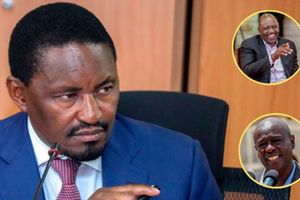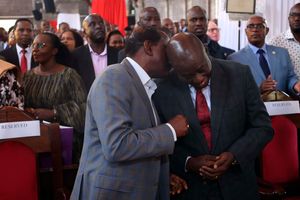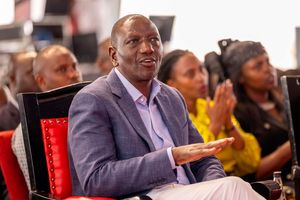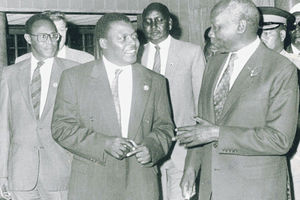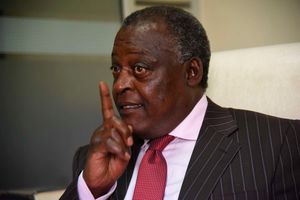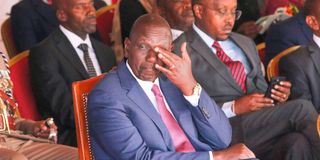
President William Ruto during the commissioning parade of 309 cadets at the Kenya Military Academy in Lanet, Nakuru County on April 16, 2025.
President William Ruto's path to re-election in 2027 is fraught with significant challenges, both from within his administration and the broader political spectrum.
From strained alliances and internal fractures, economic discontent and youth unrest, opposition resurgence, governance challenges and uncertain new partnerships, President Ruto is not sitting pretty in his quest for a second term.
Although political analysts still believe the Head of State has enough time to re-invent himself and position his camp for victory, they say he has a lot of work to do to win public confidence.
President Ruto, who heads the United Democratic Alliance (UDA), the major partner in the ruling Kenya Kwanza Alliance, has faced numerous challenges in his push for a merger with the coalition's affiliates, with only Prime Cabinet Secretary Musalia Mudavadi agreeing to have his Amani National Congress (ANC) dissolved.
While National Assembly Speaker Moses Wetang’ula's Ford Kenya, among other parties, have vehemently refused to follow suit and fold, others, such as the Democratic Party (DP) associated with former Attorney-General Justin Muturi, have triggered the coalition's exit clauses ahead of the coming elections, thus weakening the alliance.

National Assembly Speaker Moses Wetang’ula with President William Ruto in Bungoma on January 3, 2025.
Ford Kenya last week held its National Executive Committee (NEC) meeting at Elementaita where decisions were made that could further jolt the ruling coalition and upset President Ruto’s plans.
The meeting, chaired by Mr Wetang’ula, resolved that, “the party being the second oldest in the country, will not fold or merge with any other party”.
Another resolution is rebranding the party in the next three months to make it a youth friendly party ahead of 2027 as it seeks to gain support from areas that were previously ANC strongholds.
The party also resolved to field candidates in all upcoming by-elections – in Ugunja, Banissa, Malava, Magharini and at the ward level – a move that will unsettle UDA.
“Members discussed at length the issues of dissolution and merger with another party as the matter has been in public domain. They came to a conclusion that the party cannot and will not merge or dissolve to join another party. The members are of the views, as adopted by the meeting, that we can only strengthen and build the capacity of the party,” said Ford Kenya Secretary-General John Chikati.
He said that the party will compete with other parties as rivals. “No one should think that we will sit back and allow them a free ride in the by-elections. In fact, we have already identified the candidates as we wait for the IEBC to set the date.”
The Tongaren MP added that even as they work with President Ruto’s UDA, Ford Kenya will maintain its identity.
While ANC resolved to fold, a new party – the Democratic National Alliance (DNA) led by Mr Mudavadi’s former allies –was launched this month to tap into the support of the dissolved outfit, particularly in Western Kenya region, a move that does not sit well with Dr Ruto’s UDA and what it sought to achieve with the UDA-ANC merger.
DNA party leader Godfrey Kanoti and Secretary-General Barrack Muluka said the party will field candidates in all elective positions.
The impeachment of former Deputy President Rigathi Gachagua has also intensified tensions within the ruling Kenya Kwanza coalition, particularly in the Mt Kenya region—a critical voting bloc for Ruto in 2022.
The move has led to perceptions of marginalisation among key allies, potentially weakening Ruto's support base in the area.
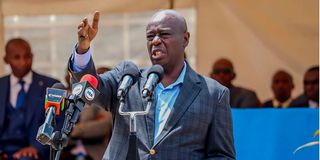
Former Deputy President Rigathi Gachagua in Mwiki on April 6, 2025.
Mr Gachagua has also vowed to launch his own political party next month to rival the UDA, with the aim of eradicating its influence from the area ahead of the 2027 elections.
Prof Gitile Naituli of Multimedia University says President Ruto “indeed faces a complex and narrowing path to re-election in 2027”.
“While incumbency gives him certain structural advantages—state machinery, visibility and resources—there are several significant stumbling blocks that could undermine his bid if not addressed deftly and strategically,” the professor of management and governance says.
“The Gachagua ouster and fragmentation of Mt Kenya politics have shaken a critical pillar of Ruto’s 2022 victory. The region’s historical expectation of political reciprocity and economic empowerment remains unmet. Discontent over stalled development promises, youth unemployment, and perceptions of betrayal could dent turnout or push the bloc toward neutrality or even opposition.”
For Mr Dismas Mokua, a political analyst, President Ruto’s biggest challenge is the ‘Ruto Must Go’ mantra that has crystallised into the push for a ‘one-term presidency’.
“The one-term presidency call is seen as the representation of delivery gap and Gen Z turbulence. Former Deputy President Gachagua has used his oratory skills to position President Ruto as a one-term president. Mr Gachagua appears to derive pleasure in dragging President Ruto’s reputation through the mud. Mr Gachagua is engaging in brand assault while rubbing his hands with glee,” he argues.
The 2027 presidential elections, Mr Mokua says, is being framed as a challenge between the status quo represented by President Ruto and change represented by President Ruto’s challenger. “This narrative, if not checked, can be a game changer.”
Despite President Ruto’s UDA party entering into a Memorandum of Understanding (MoU) with the Raila Odinga-led Orange Democratic Movement (ODM) last month, the latter has continued to blow hot and cold over possible support, with the ODM leader even hinting at the party fielding a presidential candidate against the incumbent in 2027.

President William Ruto and Bomet Governor Hillary Barchok in Chepalungu, Bomet County on April 15, 2025.
ODM Deputy Party Leader Godfrey Osotsi, Secretary-General Edwin Sifuna and Siaya Governor James Orengo have cautioned against any rush to formalise a deal with President Ruto.
Mr Osotsi accuses President Ruto’s administration of not being committed to their MoU.
“Our MoU is on 10 critical issues. One of them talks about engagement, empowerment and rights. As a party, we think that some recent State actions, including the teargassing of Butere Girls students, actually run against the spirit and the letter of our MoU,” he said.
Mr Sifuna said President Ruto was difficult to work with, adding that he could not be trusted because he had failed to rein in government officials who were prone to making mistakes.
“ODM’s ambiguity, ODM’s ideological base remains volatile. Their current hot and cold behaviour is a sign of strategic positioning—keeping options open depending on how alliances shift closer to 2027,” Prof Naituli says, arguing that this is a disadvantage for President Ruto.
Mr Gachagua, Wiper leader Kalonzo Musyoka, People's Liberation Party leader Martha Karua, DAP-Kenya's Eugene Wamalwa, former President Uhuru Kenyatta's Jubilee party among other opposition leaders have vowed to front a single candidate to face off with Dr Ruto in the 2027 election.
“If the opposition does field a joint candidate, it significantly raises the bar for Ruto’s re-election. A united opposition backed by civil society, disaffected youth, regional blocs and international goodwill could energise a formidable movement, especially if the turnout is high in traditional opposition strongholds,” Prof Naituli argues.
However, he says, the Head of State still has a chance to mitigate these challenges. “He [can] still rebuild his Mt Kenya support, choose to stabilise his Kenya Kwanza coalition by avoiding political cannibalisation within, neutralise the opposition through strategic disruption or co-option, deliver economic wins, and shape the narrative to control the ground.”
Mr Wamalwa has already alleged a plot by Dr Ruto to raid the opposition but insists they will remain united and deliver a joint candidate.
“To many Kenyans, it matters less who will be the next president, whether Wamalwa or Kalonzo, Gachagua, or Matiang’i or Karua, but it matters most who must never be president again, and that is William Ruto,” the DAP-K party leader told the Nation.
However, Mr Mokua insists that the opposition has a challenge in identifying a viable presidential candidate.
“Former Deputy President Rigathi Gachagua has not inspired confidence. His attempt to position himself as the political messiah has failed. His ‘Damascus Moment’ remains voodoo and has not crystallised as a representation of Kenya’s interests and aspirations,” he says.
On the other hand, he says that the Head of State needs to craft and execute a strategic narrative aligned to citizens’ interests and aspirations.
“President Ruto also needs to abandon strategic visibility and embrace strategic communications. While visible, President Ruto has not used policy communication tools and instruments to highlight and profile his administration’s score card. Kenya Kwanza has been winking at a girl in the dark,” Mr Mokua said.
“Strategic communications will enable President Ruto communicate his administration’s success besides building strategic partnerships and alliances around key voting blocs.”
Following Dr Ruto's fallout with his ex-DP Gachagua, and the subsequently replacement with Prof Kithure Kindiki, UDA remains undecided on whether to retain the ex-Interior CS as running mate in 2027 or drop him over rising tensions in Mt Kenya against President Ruto.
But the President now appears to be damned in whatever decision he makes on Prof Kindiki.
Dropping Prof Kindiki as his running mate in 2027, analysts have warned, could be counterproductive, especially in Mt Kenya East region that is now enjoying power.
Some analysts have warned that dropping the DP will further disenfranchise the region and make Ruto lose the support he still wields in Mt Kenya.
The rising economic discontent and youth unrest is also cited as a major concern Dr Ruto has to deal with to pacify the ground.
The Ruto administration has continued to face mounting public dissatisfaction due to economic hardships, including high unemployment rates and controversial tax policies.
The Gen Z-led protests against the Finance Bill of 2024 exemplified the growing unrest among the youth, a demographic that could significantly influence the upcoming election.
President Ruto's bid for re-election in 2027 will require navigating complex political dynamics, addressing economic grievances, and rebuilding trust among key constituencies.

